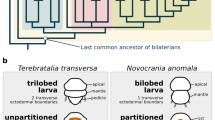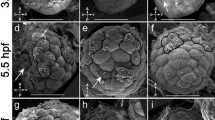Abstract
The evolution of arthropod segmentation has been studied by comparing expression patterns of pair-rule and segment polarity genes in various species. In Drosophila, the formation and maintenance of the parasegmental boundaries depend on the interactions between the wingless (wg), engrailed (en) and hedgehog (hh) genes. Until now, the expression pattern of hh has not been analysed to such a great extent as en or wg. We report the cloning and expression analysis of hh genes from Euscorpius flavicaudis, a chelicerate, and Artemia franciscana, a branchiopod crustacean. Our data provide evidence that hh, being expressed in the posterior part of every segment, is a segment polarity gene in both organisms. Additional hh expression sites were observed in the rostrum and appendages of Euscorpius and in the gut of Artemia. From the available data on hh expression in various bilaterians, we review the various hypotheses on the evolution of hh function and we suggest an ancestral role of hh in proctodeum specification and gut formation.





Similar content being viewed by others
References
Abzhanov A, Popadic A, Kaufman TC (1999) Chelicerate Hox genes and the homology of arthropod segments. Evol Dev 1:77–89
Bitgood MJ, McMahon AP (1995) Hedgehog and Bmp genes are coexpressed at many diverse sites of cell-cell interaction in the mouse embryo. Dev Biol 172:126–138
Brauer A (1894) Beitrage zur Kenntnis der Entwicklungsgeschichte des Skorpions, I. Z Wiss Zool 57:402–432
Brusca RC, Brusca GJ (2003) Invertebrates, 2nd edn. Sinauer, Sunderland, Mass.
Bumcrot DA, McMahon AP (1995) Somite differentiation. Sonic signals somites. Curr Biol 5:612–614
Capdevilla J, Johnson RL (2000) Hedgehog signalling in vertebrate and invertebrate limb patterning. Cell Mol Life Sci 57:1682–1694
Chang DT, Lopez A, von Kessler DP, Chiang C, Simandl BK, Zhao R, Seldin MF, Fallon JF, Beachy PA (1995) Products, genetic linkage and limb patterning activity of a murine hedgehog gene. Development 120:3339–3353
Damen WGM (2002) Parasegmental organization of the spider embryo implies that the parasegment is an evolutionary conserved entity in arthropod embryogenesis. Development 129:1239–1250
Damen WGM, Tautz D (1999) Comparative molecular embryology of arthropods: the expression of Hox genes in the spider Cupiennius salei. Invert Reprod Dev 36:203–209
Damen WGM, Weller M, Tautz D (1998) A conserved mode of head segmentation in arthropods revealed by the expression pattern of Hox genes in a spider. Proc Natl Acad Sci USA 95:10665–10670
Felgenhauer BE (1987) Techniques for preparing crustaceans for scanning electron microscopy. J Crustacean Biol 7:71 –76
Fietz MJ, Concordet JP, Barbosa R, Johnson R, Krauss S, McMahon AP, Tabin C, Ingham PW (1994) The hedgehog gene family in Drosophila and vertebrate development. Dev Suppl :43–51
Frhoman MA, Dush MK, Martin GR (1988) Rapid production of full-length cDNAs from rare transcripts: amplification using single gene-specific oligo-nucleotide primer. Proc Natl Acad Sci USA 85:8998–9002
Gibert J-M, Mouchel-Vielh E, Quéinnec E, Deutsch JS (2000) Barnacle duplicate engrailed genes: divergent expression patterns and evidence for a vestigial abdomen. Evol Dev 2:194–202
Haas MS, Brown SJ, Beeman RW (2001a) Homeotic evidence for the appendicular origin of the labrum in Tribolium castaneum. Dev Genes Evol 211:96–102
Haas MS, Brown SJ, Beeman RW (2001b) Pondering the procephalon: the segmental origin of the labrum. Dev Genes Evol 211:89–95
Hammerschmidt M, Brook A, McMahon AP (1997) The world according to hedgehog. Trends Genet 13:14–21
Hoch M, Pankratz MJ (1996) Control of gut development by fork head and cell signaling molecules in Drosophila. Mech Dev 58:3–14
Hughes CL, Kaufman TC (2002) Exploring myriapod segmentation: the expression patterns of even-skipped, engrailed, and wingless in a centipede. Dev Biol 247:47–61
Ingham PW, McMahon AP (2001) Hedgehog signaling in animal development: paradigms and principles. Genes Dev 15:3059–3087
Inoue Y, Niwa N, Mito T, Ohuchi H, Yoshioka H, Noji S (2002) Expression patterns of hedgehog, wingless, and decapentaplegic during gut formation of Gryllus bimaculatus (cricket). Mech Dev 110:245–248
Janssen R, Prpic NM, Damen WG (2004) Gene expression suggests decoupled dorsal and ventral segmentation in the millipede Glomeris marginata (Myriapoda: Diplopoda). Dev Biol 268:89–104
Kang D, Huang F, Li D, Shankland M, Gaffield W, Weisblat DA (2003) A hedgehog homolog regulates gut formation in leech (Helobdella). Development 30:1645–1657
Keys DN, Lewis DL, Selegue JE, Pearson BJ, Goodrich LV, Johnson RL, Gates J, Scott MP, Carroll SB (1999) Recruitment of a hedgehog regulatory circuit in butterfly eyespot evolution. Science 283:532–534
Kumar S, Tamura K, Jakobsen IB, Nei M (2001) MEGA2: molecular evolutionary genetics analysis software. Bioinformatics 17:1244–1245
Lee JJ, von Kessler DP, Parks S, Beachy PA (1992) Secretion and localized transcription suggest a role in positional signaling for products of the segmentation gene hedgehog. Cell 71:33–50
Lee JJ, Ekker SC, von Kessler DP, Porter JA, Sun BI, Beachy PA (1994) Autoproteolysis in Hedgehog protein biogenesis. Science 266:1528–1537
Manton SM (1977) The Arthropoda: habits, functional morphology and evolution. Oxford University Press, Oxford
Min GS, Kim SH, Kim W (1998) Molecular phylogeny of arthropods and their relatives: polyphyletic origin of arthropodization. Mol Cells 8:75–83
Mittmann B and Scholtz G (2003) Development of the nervous system in the “head” of Limulus polyphemus (Chelicerata: Xiphosura): morphological evidence for a correspondence between the segments of the chelicerae and of the (first) antennae of Mandibulata. Dev Genes Evol 213:9–17
Miyawaki K, Mito T, Sarashina I, Zhang H, Shinmyo Y, Ohuchi H, Noji S (2004) Involvement of Wingless/Armadillo signaling in the posterior sequential segmentation in the cricket, Gryllus bimaculatus (Orthoptera), as revealed by RNAi analysis. Mech Dev 121:119–130
Mohler J, Vani K (1992) Molecular organization and embryonic expression of the hedgehog gene involved in cell-cell communication in segmental patterning of Drosophila. Development 115:957–971
Mouchel-Vielh E, Rigolot C, Gibert J-M, Deutsch JS (1998) Molecules and the body plan: the Hox genes of cirripedes (Crustacea). Mol Phylogenet Evol 9:382–389
Murakami R, Shiotsuki Y (2001) Ultrastructure of the hindgut of Drosophila larvae, with special reference to the domains identified by specific gene expression patterns. J Morphol 248:144–150
Nederbragt AJ, von Lan AE, Dictus WJAG (2002) Hedgehog crosses the snail’s midline. Nature 417:811–812
Niwa N, Inoue Y, Nozawa A, Saito M, Misumi Y, Ohuchi H, Yoshioka H, Noji S (2000) Correlation of diversity of leg morphology in Gryllus bimaculatus (cricket) with divergence in dpp expression pattern during leg development. Development 127:4373–4381
Nüsslein-Volhard C, Wieschaus E (1980) Mutations affecting segment number and polarity in Drosophila. Nature 287:795–801
Popadic A, Panganiban G, Rusch D, Shear WA, Kaufman TC (1998) Molecular evidence for the gnathobasic derivation of arthropod mandibles and for the appendicular origin of the labrum and other structures. Dev Genes Evol 208:142–150
Prud’homme B, de Rosa R, Arendt D, Julien J-F, Pajatizi R, Dorresteijn AWC, Adoutte A, Wittbrodt J, Balavoine G (2003) Arthropod-like expression patterns of engrailed and wingless in the annelid Platynereis dumerilii suggest a role in segment formation. Curr Biol 13:1876–1881
Rabet N, Gibert J-M, Quéinnec E, Deutsch JS, Mouchel-Vielh E (2001) The caudal gene of the barnacle Sacculina carcini is not expressed in its vestigial abdomen. Dev Genes Evol 211:172–178
Roberts DJ, Johnson RL, Burke AC, Nelson CE, Morgan BA, Tabin C (1995) Sonic hedgehog is an endodermal signal inducing Bmp-4 and Hox genes during induction and regionalization of the chick hindgut. Development 121:3163–3174
Scholtz G (1998) Cleavage, germband formation and head segmentation: the ground pattern of Euarthropoda. In: Fortey RA, Thomas RH (eds) Arthropod relationships. Chapman and Hall, London, pp 317–332
Scholtz G, Mittmann B, Gerberding M (1998) The pattern of Distal-less expression in the mouthparts of crustacean, myriapods and insects: new evidence for a gnathobasic mandible and the common origin of Mandibulata. Int J Dev Biol 42:801–810
Schoppmeier M, Damen WGM (2001) Double-stranded RNA interference in the spider Cupiennius salei: the role of Distal-less is evolutionary conserved in arthropod appendage formation. Dev Genes Evol 211:76–82
Shimeld SM (1999) The evolution of the hedgehog gene family in chordates: insights from amphioxus hedgehog. Dev Genes Evol 209:40-47
Tabata T, Eaton S, Kornberg TB (1992) The Drosophila hedgehog gene is expressed specifically in posterior compartment cells and is a target of engrailed regulation. Genes Dev 6:2635–2645
Takatori N, Satou Y, Satoh N (2002) Expression of hedgehog genes in Ciona intestinalis embryos. Mech Dev 116:235–238
Tashiro S, Michiue T, Higashijima S, Zenno S, Ishimaru S, Takahashi F, Orihara M, Kojima T, Saigo K (1993) Structure and expression of hedgehog, a Drosophila segment-polarity gene required for cell-cell communication. Gene 124:183–189
Telford MJ, Thomas RH (1998) Expression of homeobox genes show chelicerate arthropods retain their deutocerebral segment. Proc Natl Acad Sci USA 95:10671–10675
Thomas RH, Telford MJ (1999) Appendage development in embryos of the oribatid mite Archegozetes longisetosus (Acari, Oribatei, Trhypochthoniidae). Acta Zool 80:193–200
Vortkamp A, Lee K, Lanske B, Segre GV, Kronenberg HM, Tabin C J (1996) Regulation of rate of cartilage differentiation by Indian hedgehog and PTH-related protein. Science 273:613–622
Wolpert L (1998) Principles of development. Oxford University Press, Oxford
Zardoya R, Abouheif E, Meyer A (1996) Evolution and orthology of hedgehog genes. Trends Genet 12:496–497
Acknowledgements
The authors would like to thank Roland Stockmann (University Paris 6) for his kind help in collecting animals and for discussions about the development of Euscorpius, Maryline Blin for her molecular expertise and Nicolas Rabet for help with SEM. The advised comments of Michael Manuel helped improve the manuscript. We acknowledge Diethard Tautz for his helpful remark on the difference between chelicerates and pan-crustaceans. F.S. is the recipient of a Ph.D. fellowship from the Ministère de la Recherche et de la Technologie.
Author information
Authors and Affiliations
Corresponding author
Additional information
Edited by D. Tautz
Rights and permissions
About this article
Cite this article
Simonnet, F., Deutsch, J. & Quéinnec, E. hedgehog is a segment polarity gene in a crustacean and a chelicerate. Dev Genes Evol 214, 537–545 (2004). https://doi.org/10.1007/s00427-004-0435-z
Received:
Accepted:
Published:
Issue Date:
DOI: https://doi.org/10.1007/s00427-004-0435-z




